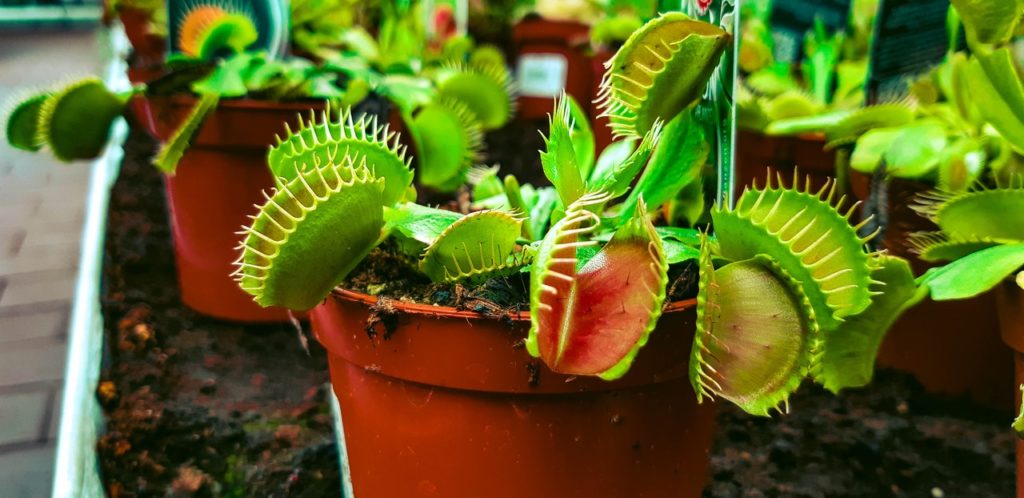
I learned this today. Venus flytraps know when to close on an insect because of tiny hairs inside them.
Venus flytraps are carnivorous plants that grow in the subtropical wetlands of the United States. They live in nutrient-poor soil, specifically nitrogen-poor soil, which is the main reason they have evolved to eat insects. The plants are not very big, and each stem has a trap at the end of it. The trap has two halves, and each half has spikes around the rims. When the trap is open, the two halves are convex in shape. The Venus flytrap secretes nectar onto the trap. The nectar is sweet and attracts flies and other insects. Then the magic happens.
Inside the Venus flytrap are short hairs. When an insect lands on or crawls into the trap, it stimulates these hairs. Each time the Venus flytrap shuts, it expends energy so, in order not to close when it is empty and use energy for no reason, the trap only springs when two separate hairs have been triggered within 30 seconds. If only one hair is triggered, the trap won’t shut. If two hairs are triggered but more than 30 seconds apart, the trap won’t shut. This prevents the Venus flytrap from wasting energy by shutting when nothing but a piece of dust has landed in it.
When an insect enters the trap and touches a hair, calcium ions start to move and create an electrical difference across the cells. If a second hair isn’t stimulated, this difference dissipates, over about 30 seconds. If a second hair is stimulated, the combined electrical difference makes a charge that travels to the hinge of the trap. This charge stimulates cells as it moves and causes water to rush from cells on the inside of the trap to cells on the outside. The moving water makes the trap change its shape from convex to concave. This creates a sudden change in pressure that makes the trap snap shut.
From the stimulation of the second hair to the trap closing takes 100 milliseconds. Flies can react to a stimulus in about 5 milliseconds, but the long spikes on each lip of the trap make an inescapable prison before the sides of the trap have actually shut.
Once the trap is shut, the plant doesn’t start to digest the insect straight away. It has evolved another step that allows it to make sure it has actually caught an insect rather than an inedible piece of dirt. The Venus flytrap waits until 5 more hairs have been triggered before it starts to digest. That means that the Venus flytrap is technically able to count and has a short-term memory! By waiting for five hairs to be triggered, the Venus flytrap can be sure that something alive and moving is trapped inside it.
After five hairs have been triggered, the trap makes an airtight seal and releases digestive enzymes. These enzymes break down the cells of the insect and turn the proteins into smaller chains of amino acids. The plant dissolves the insect and absorbs the nitrogen from it, making up for the lack of nitrogen in the poor soil it is growing in.
It takes about ten days for the Venus flytrap to digest the insect. After ten days have passed, the trap opens and the parts of the insect that can’t be digested fall out.
Venus flytraps evolved from carnivorous plants that use a sticky trap to catch insects. The problem with this method is the trap will only hold very small insects. The Venus flytrap evolved its trap method to be able to catch larger insects, which have more nutrients in them.
The Venus flytrap can trap and digest most insects, but some stronger beetles and spiders can chew their way out of it.
So, the Venus flytrap closes when an insect lands on its trap and stimulates two hairs. This creates an electrical current that causes water to flow from cells and change the shape of the trap, making it snap shut. The Venus flytrap then digests the insect using enzymes so it can absorb the nitrogen, making up for the poor soil it is growing in. And that is what I learned today.
Sources
https://en.wikipedia.org/wiki/Venus_flytrap
https://homeguides.sfgate.com/venus-flytrap-trap-flies-74657.html
https://www.countryliving.com/uk/homes-interiors/gardens/a35391400/venus-flytraps/
https://www.britannica.com/plant/Venus-flytrap
